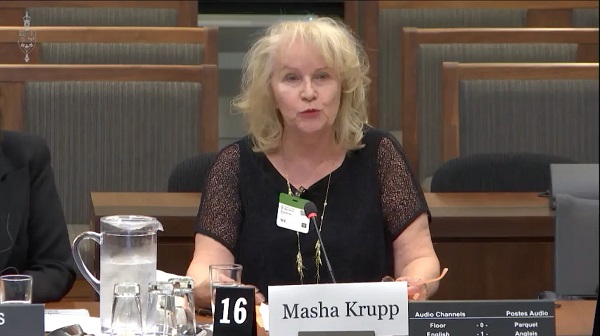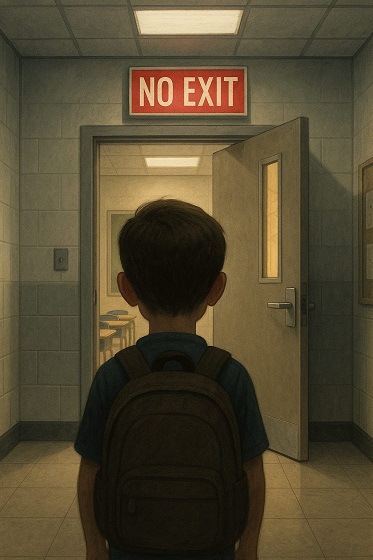Addictions
‘Our Liberal Government Is Acting Like A Drug Lord’: A Mother’s Testimony

By Adam Zivo
“As soon as [my son] was put on safe supply, he started diverting his safe supply” Mom tells Parliament safer supply isn’t working
“The whole purpose of the safer supply program was to divert addicts from using harmful street drugs, but that’s not happening,” testified Masha Krupp, an Ottawa-based mother, at the House of Commons Health Committee last week. Exhausted and blunt, she described how her son has, in the past, diverted his “safer supply” drugs to the black market and how she has personally witnessed widespread diversion, by other patients, outside the clinic her son attends.
Safer supply programs distribute free addictive drugs – typically hydromorphone, a heroin-strength opioid – under the belief that this stabilizes addicts and dissuades them from consuming riskier street substances. Addiction experts and police leaders across Canada, however, say that recipients regularly divert these taxpayer-funded drugs to the black market, fueling new addictions and gang profits.
The Liberals and NDP have denied that widespread safer supply diversion is occurring, despite ample evidence to the contrary – but Krupp’s lived experiences underline the folly of their willful blindness.
“As soon as he was put on safe supply, he started diverting his safe supply,” she testified. “You’ve got drug dealers – I know this for a fact through my son; I’ve seen it – they will come to your home, 24/7, you can call two in the morning. They take your hydromorphone pills.”
According to Krupp, her son’s addiction issues have not improved despite him being enrolled in a safer supply program for more than two years. He still uses fentanyl and crack cocaine, which led to yet another overdose just last month, she said, adding that diversion and a lack of recovery-oriented services contribute to his instability.
“The Dilaudid (brand name hydromorphone) is a means of currency for my son to continue using crack cocaine – so it’s not safe, because he’s still using unsafe street drugs,” she said in parliament.
Krupp further explained that, on multiple occasions, she witnessed and photographed patients selling their safer supply in front of the clinic where her son has been a patient since June 2021. The transactions were not subtle: she could see them counting and exchanging white pills.
Over time, Krupp corroborated these observations by acquainting herself with some of these patients, who would admit to selling their safer supply: “I get to know all these people that are diverting and using right in front of the clinic, in front of all the tourists, parents walking by with kids.”
She believes that safer supply could have a role in addiction care if it were better regulated, but feels that the current model, where supervised consumption of these drugs is rarely required, is only “flooding the market, using taxpayers’ dollars, with lethal opiates…”
“It’s unsafe supply, in my view, as a mother with lived experience,” said Krupp. “Our Liberal government, right now, is acting like a drug lord.”
Her testimony was consistent with what was described in a CBC investigative report published last February, wherein Ottawa’s police officers confirmed that safer supply diversion is rampant.
One constable quoted in the story, Paul Stam, said that virtually anytime police would pull up to Rideau and Nelson street, where the clinic Krupp’s son attends is located, “they would observe people openly trafficking in diverted hydromorphone.” The officer further told the CBC that the “street is flooded with this pharmaceutical grade hydromorphone” and that there has been a dramatic, province-wide reduction in the drug’s blackmarket price – from $8-9 per 8-mg pill to just $1-2 today.
Although Krupp gave her parliamentary testimony last week, I interviewed her in July and kept her story private at her request – at the time, she worried that going public could interfere with her son’s attempts at recovery.
In the July interview, Krupp explained that, not only had her son told her that safer supply diversion is ubiquitous, she had also heard this from two acquaintances of his, who were also on the program: “The information that I’ve received is that the drug dealers have operations set up 24/7 across the city, buying legal dillies (the slang term for hydromorphone).”
She explained that she had been able to witness and document safer supply diversion because, on most Friday mornings, she would take her son to his clinic appointments and wait for him outside in her car. As she was often parked just two or three metres away from where many drug deals occurred, she had a line of sight into what was going on: clearly-identifiable dillies being handed over for other drugs.
She estimated that, by that point, she had cumulatively witnessed at least 25 safer supply patients engage in diversion.
“[Safer supply patients] would trade their dillies for fentanyl and/or crack cocaine and smoke or inject it right in front of me. They would just huddle in a corner. It’s all done very openly,” she said. “What I witness, to me, is a human tragedy on the sidewalks of the nation’s capital, with Parliament Hill eight or nine blocks away, and all the politicians sitting there singing praises to safer supply.”
She pushed back on the narrative, popular among Liberal and NDP politicians, that criticism of safer supply is conservative fear mongering and said that she had voted NDP in the past, and had even voted for Trudeau in 2015. Her disgust with safer supply was simply her “speaking from the heart as a mother.”
While harm reduction activists claim that safer supply is a form of compassionate care, Krupp vehemently disagreed: “How is it compassionate to fuel somebody’s addiction? How is it humane to keep a perpetual cycle of drug abuse and dependence?”
Subscribe to Break The Needle. Our content is always free – but if you want to help us commission more high-quality journalism, consider getting a voluntary paid subscription.
Addictions
Canada is divided on the drug crisis—so are its doctors

When it comes to addressing the national overdose crisis, the Canadian public seems ideologically split: some groups prioritize recovery and abstinence, while others lean heavily into “harm reduction” and destigmatization. In most cases, we would defer to the experts—but they are similarly divided here.
This factionalism was evident at the Canadian Society of Addiction Medicine’s (CSAM) annual scientific conference this year, which is the country’s largest gathering of addiction medicine practitioners (e.g., physicians, nurses, psychiatrists). Throughout the event, speakers alluded to the field’s disunity and the need to bridge political gaps through collaborative, not adversarial, dialogue.
This was a major shift from previous conferences, which largely ignored the long-brewing battles among addiction experts, and reflected a wider societal rethink of the harm reduction movement, which was politically hegemonic until very recently.
Recovery-oriented care versus harm reductionism
For decades, most Canadian addiction experts focused on shepherding patients towards recovery and encouraging drug abstinence. However, in the 2000s, this began to shift with the rise of harm reductionism, which took a more tolerant view of drug use.
On the surface, harm reductionists advocated for pragmatically minimizing the negative consequences of risky use—for example, through needle exchanges and supervised consumption sites. Additionally, though, many of them also claimed that drug consumption is not inherently wrong or shameful, and that associated harms are primarily caused not by drugs themselves but by the stigmatization and criminalization of their use. In their view, if all hard drugs were legalized and destigmatized, then they would eventually become as banal as alcohol and tobacco.
The harm reductionists gained significant traction in the 2010s thanks to the popularization of street fentanyl. The drug’s incredible potency caused an explosion of deaths and left users with formidable opioid tolerances that rendered traditional addiction medications, such as methadone, less effective. Amid this crisis, policymakers embraced harm reduction out of an immediate need to make drug use slightly less lethal. This typically meant supervising consumption, providing sterile drug paraphernalia, and offering “cleaner” substances for addicts to use.
Many abstinence-oriented addiction experts supported some aspects of harm reduction. They valued interventions that could demonstrably save lives without significant tradeoffs, and saw them as both transitional and as part of a larger public health toolkit. Distributing clean needles and Naloxone, an overdose-reversal medication, proved particularly popular. “People can’t recover if they’re dead,” went a popular mantra from the time.
Saving lives or enabling addiction?
However, many of these addiction experts were also uncomfortable with the broader political ideologies animating the movement and did not believe that drug use should be normalized. Many felt that some experimental harm reduction interventions in Canada were either conceptually flawed or that their implementation had deviated from what had originally been promised.
Some argued, not unreasonably, that the country’s supervised consumption sites are being mismanaged and failing to connect vulnerable addicts to recovery-oriented care. Most of their ire, however, was directed at “safer supply”—a novel strategy wherein addicts are given free drugs, predominantly hydromorphone (a heroin-strength opioid), without any real supervision.
While safer supply was meant to dissuade recipients from using riskier street drugs, addiction physicians widely reported that patients were selling their free hydromorphone to buy stronger illicit fentanyl, thereby flooding communities with diverted opioids and exacerbating the addiction crisis. They also noted that the “evidence base” behind safer supply was exceptionally poor and would not meet normal health-care standards.
Yet, critics of safer supply, and harm reduction radicalism more broadly, were often afraid to voice their opinions. The harm reductionists were institutionally and culturally dominant in the late 2010s and early 2020s, and opponents often faced activist harassment, aggressive gaslighting, and professional marginalization. A culture of self-censorship formed, giving both the public and influential policymakers a false impression of scientific consensus where none actually existed.
The resurgence in recovery-oriented strategies
Things changed in the mid-2020s. British Columbia’s failed drug decriminalization experiment eroded public trust in harm reductionism, and the scandalous failures of safer supply—and supervised consumption sites, too—were widely publicized in the national media.1
Whereas harm reductionism was once so powerful that opponents were dismissed as anti-scientific, there is now a resurgent interest in alternative, recovery-oriented strategies.
These cultural shifts have fuelled a more fractious, but intellectually honest, national debate about how to tackle the overdose crisis. This has ruptured the institutional dominance enjoyed by harm reductionists in the addiction medicine world and allowed their previously silenced opponents to speak up.
When I first attended CSAM’s annual scientific conference two years ago, recovery-oriented critics of radical harm reductionism were not given any platforms, with the exception of one minor presentation on safer supply diversion. Their beliefs seemed clandestine and iconoclastic, despite seemingly having wide buy-in from the addiction medicine community.
While vigorous criticism of harm reductionism was not a major feature of this year’s conference, there was open recognition that legitimate opposition to the movement existed. One major presentation, given by Dr. Didier Jutras-Aswad, explicitly cited safer supply and involuntary treatment as two foci of contention, and encouraged harm reductionists and recovery-oriented experts to grab coffee with one another so that they might foster some sense of mutual understanding.2
Is this change enough?
While CSAM should be commended for encouraging cross-ideological dialogue, its efforts, in this respect, were also superficial and vague. They chose to play it safe, and much was left unsaid and unexplored.
Two addiction medicine doctors I spoke with at the conference—both of whom were critics of safer supply and asked for anonymity—were nonplussed. “You can feel the tension in the air,” said one, who likened the conference to an awkward family dinner where everyone has tacitly agreed to ignore a recent feud. “Reconciliation requires truth,” said the other.
One could also argue that the organization has taken an inconsistent approach to encouraging respectful dialogue. When recovery-oriented experts were being bullied for their views a few years ago, they were largely left on their own. Now that their side is ascendant, and harm reductionists are politically vulnerable, mutual respect is in fashion again.
When I asked to interview the organization about navigating dissension, they sent a short, unspecific statement that emphasized “evidence-based practices” and the “benefits of exploring a variety of viewpoints, and the need to constantly challenge or re-evaluate our own positions based on the available science.”
But one cannot simply appeal to “evidence-based practices” when research is contentious and vulnerable to ideological meddling or misrepresentation.
Compared to other medical disciplines, addiction medicine is highly political. Grappling with larger, non-empirical questions about the role of drug use in society has always necessitated taking a philosophical stance on social norms, and this has been especially true since harm reductionists began emphasizing the structural forces that shape and fuel drug use.
Until Canada’s addiction medicine community facilitates a more robust and open conversation about the politicization of research, and the divided—and inescapably political—nature of their work, the national debate on the overdose crisis will be shambolic. This will have negative downstream impacts on policymaking and, ultimately, people’s lives.
Our content is always free – but if you want to help us commission more high-quality journalism,
consider getting a voluntary paid subscription.
Addictions
The War on Commonsense Nicotine Regulation

From the Brownstone Institute
Cigarettes kill nearly half a million Americans each year. Everyone knows it, including the Food and Drug Administration. Yet while the most lethal nicotine product remains on sale in every gas station, the FDA continues to block or delay far safer alternatives.
Nicotine pouches—small, smokeless packets tucked under the lip—deliver nicotine without burning tobacco. They eliminate the tar, carbon monoxide, and carcinogens that make cigarettes so deadly. The logic of harm reduction couldn’t be clearer: if smokers can get nicotine without smoke, millions of lives could be saved.
Sweden has already proven the point. Through widespread use of snus and nicotine pouches, the country has cut daily smoking to about 5 percent, the lowest rate in Europe. Lung-cancer deaths are less than half the continental average. This “Swedish Experience” shows that when adults are given safer options, they switch voluntarily—no prohibition required.
In the United States, however, the FDA’s tobacco division has turned this logic on its head. Since Congress gave it sweeping authority in 2009, the agency has demanded that every new product undergo a Premarket Tobacco Product Application, or PMTA, proving it is “appropriate for the protection of public health.” That sounds reasonable until you see how the process works.
Manufacturers must spend millions on speculative modeling about how their products might affect every segment of society—smokers, nonsmokers, youth, and future generations—before they can even reach the market. Unsurprisingly, almost all PMTAs have been denied or shelved. Reduced-risk products sit in limbo while Marlboros and Newports remain untouched.
Only this January did the agency relent slightly, authorizing 20 ZYN nicotine-pouch products made by Swedish Match, now owned by Philip Morris. The FDA admitted the obvious: “The data show that these specific products are appropriate for the protection of public health.” The toxic-chemical levels were far lower than in cigarettes, and adult smokers were more likely to switch than teens were to start.
The decision should have been a turning point. Instead, it exposed the double standard. Other pouch makers—especially smaller firms from Sweden and the US, such as NOAT—remain locked out of the legal market even when their products meet the same technical standards.
The FDA’s inaction has created a black market dominated by unregulated imports, many from China. According to my own research, roughly 85 percent of pouches now sold in convenience stores are technically illegal.
The agency claims that this heavy-handed approach protects kids. But youth pouch use in the US remains very low—about 1.5 percent of high-school students according to the latest National Youth Tobacco Survey—while nearly 30 million American adults still smoke. Denying safer products to millions of addicted adults because a tiny fraction of teens might experiment is the opposite of public-health logic.
There’s a better path. The FDA should base its decisions on science, not fear. If a product dramatically reduces exposure to harmful chemicals, meets strict packaging and marketing standards, and enforces Tobacco 21 age verification, it should be allowed on the market. Population-level effects can be monitored afterward through real-world data on switching and youth use. That’s how drug and vaccine regulation already works.
Sweden’s evidence shows the results of a pragmatic approach: a near-smoke-free society achieved through consumer choice, not coercion. The FDA’s own approval of ZYN proves that such products can meet its legal standard for protecting public health. The next step is consistency—apply the same rules to everyone.
Combustion, not nicotine, is the killer. Until the FDA acts on that simple truth, it will keep protecting the cigarette industry it was supposed to regulate.
-

 Business2 days ago
Business2 days agoCarney shrugs off debt problem with more borrowing
-

 Alberta1 day ago
Alberta1 day agoWhen Teachers Say Your Child Has Nowhere Else to Go
-

 Automotive2 days ago
Automotive2 days agoThe high price of green virtue
-

 Addictions1 day ago
Addictions1 day agoCanada is divided on the drug crisis—so are its doctors
-

 Bruce Dowbiggin1 day ago
Bruce Dowbiggin1 day agoMaintenance Mania: Since When Did Pro Athletes Get So Fragile?
-

 Daily Caller2 days ago
Daily Caller2 days agoProtesters Storm Elite Climate Summit In Chaotic Scene
-

 MAiD2 days ago
MAiD2 days agoQuebec has the highest euthanasia rate in the world at 7.4% of total deaths
-

 National1 day ago
National1 day agoConservative bill would increase penalties for attacks on places of worship in Canada











